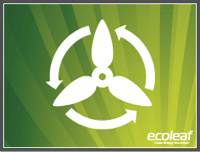ECOLEAF: Renewable Wind Powered Energy



The good news is that over the last 20 years, wind turbines have become more reliable thanks to upgraded features (i.e., variable-speed functionality) which allow the turbines to convert wind to energy at different speeds.
Global Wind Energy Capacity in 2005: 59GW
Global Wind Energy Capacity in 2006: 74GW
US Wind electricity consumption in 2005: 17,810 GWh
US Wind Energy Capacity in 2005: 9.2GW
US Wind Energy Capacity in 2006: 11.6GW
US Wind Capacity Usage in 2006: 24% of 11,351 MW
Germany Wind Energy Capacity in 2005: 18.4GW
Germany Wind Energy Capacity in 2006: 20.6GW
Spain Wind Energy Capacity in 2005: 10GW
Spain Wind Energy Capacity in 2006: 11.6GW
Wind turbines are currently the largest provider of renewable energy on the world’s energy market. (Excluding hydropower, which has limited growth opportunities.) These wind turbines have outputs ranging from 100kW to several MW. Wind turbines operate (either into the wind or facing away from the wind) with a minimum wind speed range of 8 to 16 mph and a maximum speed of 55 mph; wind gusts greater than 55 mph can damage the turbines. Gears within the turbine shift the rotational speeds from a low of 30-60 RPM to a high of 1000-1800 RPM. This generates electricity at a level of 60 cycle AC, whereupon a transformer is used to transfer the energy to the grid. The reliability of turbines is improving due to the fact that active dampening reduces maintenance costs and downtime and thus increases useful life. On the flip side, however, there are high installation/building expenses, the cost of constructing and maintaining the turbines, the cost of leasing land for the wind towers, and the costs of transmitting and distributing the power they generate to the national grid.
Wind energy costs between $.04 to $.06/kWh--but it requires a higher initial investment, which brings the cost up to $.08/kWh. Wind turbines are, however, becoming more efficient (meaning less maintenance and fewer failures). As of January 2008, the largest installations of wind capacity in the U.S. are in Texas (4.3GW) and California (2.4GW). This is followed by Washington, Colorado, Minnesota, and Iowa, each of which averages 1.2GW. One GW typically provides power for 300,000 residences.
In 2005, wind power had a worldwide capacity of 59GW, with the U.S. representing 15.6% (or 9.2GW) of renewable energy production. Installations of wind turbines continue to grow in the U.S. and reached a domestic capacity of 16.8GW and a worldwide capacity of 94GW in 2007. This means an average 24%-increase per year over the last five years, totaling an additional capacity of 5GW and a cost of nearly $9 billion.
In 2007, Wind Capacity Figures in the US with a capacity of 1GW or more:
Texas: 4356 MW (25.9% of the US Wind Power Generation)
California: 2439 MW (14.5% of the US Wind Power Generation)
Minnesota: 1299 MW (7.7% of the US Wind Power Generation)
Iowa: 1273 MW (7.6% of the US Wind Power Generation)
Washington: 1163 MW (6.9% of the US Wind Power Generation)
Colorado: 1067 MW (6.3% of the US Wind Power Generation)
As of mid-2008, the U.S. was generating 19.5GW with wind power. (Germany came in higher with a figure of 23GW). Clipper Windpower and BP Alternative Energy are working on installing a 5GW-capacity wind farm in South Dakota.
PICKENS WIND FARM: T. Boone Pickens is planning a 4GW-capacity wind farm in Texas. This farm will have a purchase price of $10 billion and will include 2,700 turbines. To make this a reality, a 250-mile transmission line may also have to be installed. It’s estimated that a 10%-energy buffer will be needed to guarantee a constant flow of energy—that is, to counteract potential blackouts that could occur when there isn’t enough energy in the line. This buffer is not included in the total costs since the system is still dependent on coal and nuclear energy as the baseline of energy—the wind would be secondary.
PICKENS WIND FARM UPDATE: Mr. Pickens recently abandoned his plans due to the drastic drop in the price of oil. This decrease made executing his original plans potentially unfeasible (at least, for the near future). Petroleum-generated energy only accounts for 3% of the net power generated in the U.S. The fluctuation in oil prices does have a secondary effect on coal-fired power plants—coal is more expensive when oil prices rise because the fuel costs for operating mining equipment and transporting coal rise in tandem. Conversely, when oil prices drop, so does the price of coal-generated power.
WIND ENERGY Companies
Abb Ltd.
Windtec
Acciona
Siemens
Vestas
TPI Composites
LM Glasfiber
DMI
Molded Fiberglass
Hendricks Industries
PPG Industries
American Superconductor
WIND TECHNOLOGY
Clipper Windpower
Atlantic Wind and Solar Inc.
Horizon Wind Energy
Acciona SA
General Electric (GE)
Mesa Power
Siemens
Trinity Structural Towers
Tower Tech
WIND ENERGY People
Jason Fredette, American Superconductor
Bob Gates, VP of Operations, Clipper Windpower
Gabriel Alonso, Chief Development Officer, Horizon Wind Energy
Stan Calvert, U.S. Energy Department
T.Boone Pickens
David Murdock
Michael Bloomberg, Mayor, New York City
WIND POWER Providers
TXU Energy
Iberdrola SA
WIND ENERGY Associations
American Wind Energy Association (AWEA)
American Wind-Wildlife Institute
National Wind Coordinating Collaborative
Bats & Wind Energy Cooperative (BWEC)
WIND ENERGY Labs & Government Organizations
National Renewable Energy Laboratory (NREL)
Lawrence Berkeley National Laboratory (LBNL)
Federal Energy Regulatory Commission
WIND POWERED ENERGY



Stay Informed
Get updates and action alerts.



back
next

Delivering Green Clarity in a Carbon-Troubled World™
Copyright © 2008 - 2010 by ECOLEAF™. All rights reserved.
Reproduction in whole or in part without permission is prohibited.
